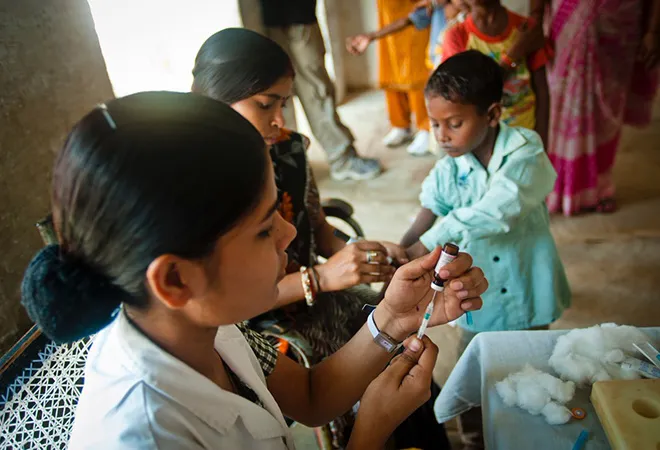A staggering five women die every hour in India due to causes related to
pregnancy and childbirth. And
two-thirds of the around 45,000 such deaths annually occur outside any medical facility, that is, either at homes or en route to hospitals.
This is despite a
slow improvement in the maternal mortality ratio (MMR) in the country. As appropriate medical surveillance and intervention can almost entirely prevent maternal deaths, MMR is deemed a sensitive indicator of the general quality of a health system, according to the
World Health Organisation.
Hence, this abysmal mortality rate reflects a general lack of physical and financial access to healthcare, which is a fact of life for many Indian households.
Yet, a bizarre and parallel narrative is unfolding across the country.
In contrast to such under-provisioning of maternal care, there is an emergent story of over-provisioning too, in rich and poor states alike. And nothing demonstrates this phenomenon better than the
“Caesarean Epidemic.”
A caesarean section or a C-section is a delivery through a surgical incision in the mother’s abdomen and uterus, in situations where a vaginal delivery could put the baby or mother at medical risk. However, disturbingly, more pregnant women in India are going under the scalpel for deliveries than is normal.
The WHO made it unequivocally clear in
a 2015 statement that C-section rates higher than 10% do not help reduce maternal and newborn mortality rates. But India crossed this threshold way back in 2005 when the figure
hit 10.6%.
While
the media has
reported on the issue before, the latest numbers released by the National Family Health Survey (NFHS 2015-16) once again underline the acute problem.
A cross-section
While national-level data is yet to be published, here’s a look at the numbers from five states: Uttar Pradesh (UP), Goa, Punjab, Uttarakhand, and Manipur.
While representing the country’s socio-economic diversity, and holding a mirror to the national situation, these states are also important because they are now at various stages of holding elections to their legislative assemblies. In each of these, the numbers pose a public health threat.
Notably, the increase in the rate of C-sections over the last decade seems to be largely driven by the private sector in these states.
As we await the latest data from UP, it is safe to say that among the five states, at least one in three deliveries in private hospitals are by C-section. And analysis of
NFHS 2015-16 data shows that in states like Goa and Manipur, it is one in two deliveries.
Meanwhile, even a poor state like UP has districts like Banda (58.7%), Basti (38.1%), Gorakhpur (39.5%), Pilibhit (40.8%) and Sonbhadra (39.7%) with very high proportions of C-sections in private hospitals, as data from the
Annual Health Survey 2012-13 suggests.
In many of Punjab’s districts, the share is
more than half.
A bizarre fad
The main reasons cited for undergoing C-sections are: to avoid the
excruciating pain of normal childbirth, doctor’s convenience, profiteering, and cultural issues like the
“mahurat baby” fad. However, reducing a C-section to a minor procedure resorted to for convenience’s sake trivialises the risks involved.
As the
WHO points out, like any major surgery, “Caesarean sections are associated with short and long term risk which can extend many years beyond the current delivery and affect the health of the woman, her child, and future pregnancies.”
In 2013, The American College of Obstetricians and Gynecologists
issued a statement against what is known as “maternal-request caesareans” or C-sections done at the request of the mother without a medical condition. It said that women undergoing C-sections face the risk of infection as well as bladder and bowel injuries during surgery, along with serious complications like placental problems, uterine rupture, and emergency hysterectomy.
If nothing, India has another major reason to immediately deal with the epidemic. Babies born vaginally have
fewer respiratory problems. A 2014 study showed that C-section babies have a considerably
increased risk for asthma.
Given the alarming rates of pollution across our country, especially its cities, and the already
high burden of respiratory infections, Indian parents seeking a convenient C-section may be unwittingly gifting their child a chronic disease.
Systematic studies to establish the connection between the burden of asthma in children and C-section will be a first step towards the long-term management of this public health problem, particularly in regions that are the hot spots.
It is heartening that many influential doctors have themselves begun advocating against
medically unnecessary C-sections. A recent
online petition demanding the union health ministry to mandate hospitals to publicly declare the share of C-section deliveries indicates a growing public awareness.
Will it turn into concrete action? Only time will tell.
Part 1: < style="color: #960f0f">Down to the district: The health of 5 states going to polls
Part 2: < style="color: #960f0f">#Elections2017 : UP spends least on health, reflects in its ill-health
Part 3: < style="color: #960f0f">#Elections2017: More wasted children, anaemic men, women than before in Punjab
Part 4: < style="color: #960f0f">#Elections2017: New worries creep into seemingly healthy Goa
Part 5: < style="color: #960f0f">#Elections2017: Uttarakhand has rich people–and children with poor health
Part 6 : < style="color: #960f0f">UP’s health variations: From worse than Haiti to better than India
This commentary originally appeared in Quartz India.
The views expressed above belong to the author(s). ORF research and analyses now available on Telegram! Click here to access our curated content — blogs, longforms and interviews.






 PREV
PREV


